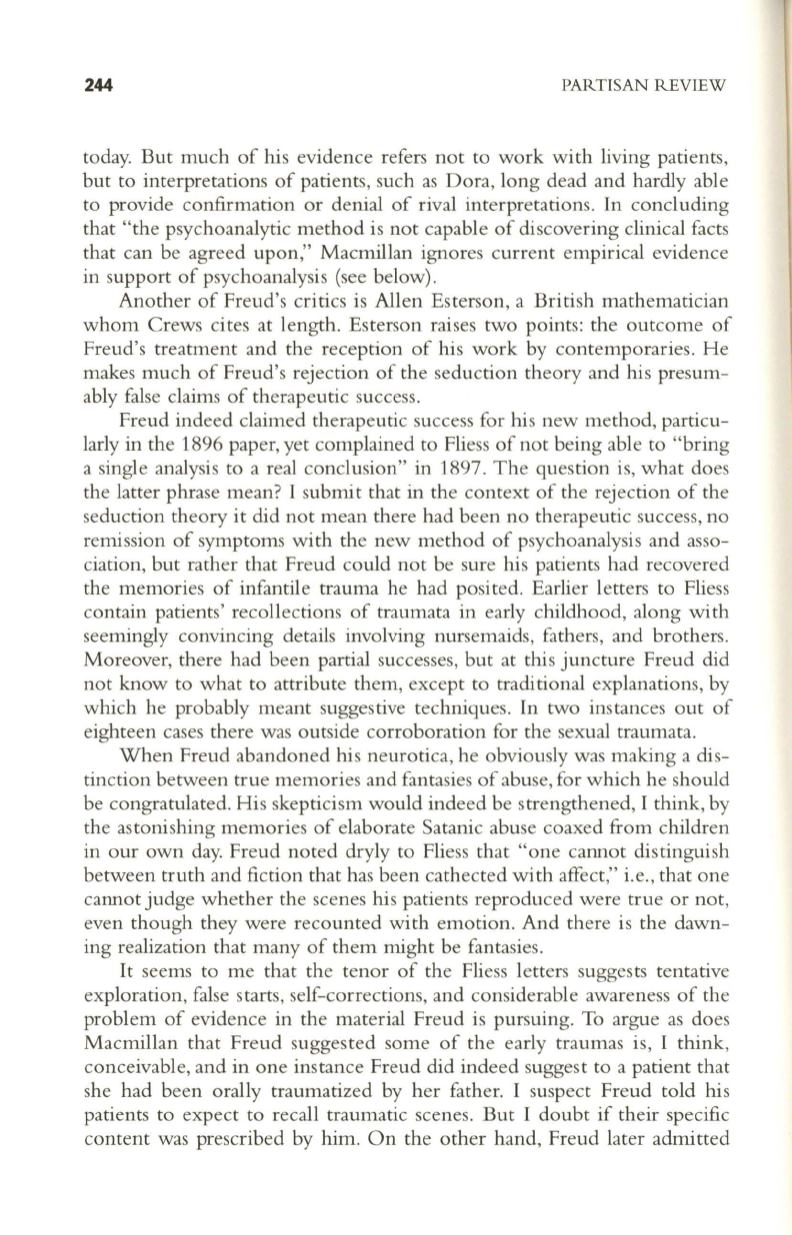
244
PARTISAN REVIEW
today. But much of his evidence refers not to work with living patients,
but to interpretations of patients, such as Dora, long dead and hardly able
to provide confirmation or denial of rival interpretations. In concluding
that "the psychoanalytic method is not capable of discovering clinical facts
that can be agreed upon," Macmillan ignores current empirical evidence
in support of psychoanalysis (see below).
Another of Freud's critics is Allen Esterson, a British mathematician
whom Crews cites at length. Esterson raises two points: the outcome of
Freud's treatment and the reception of his work by contemporaries. He
makes much of Freud's rejection of the seduction theory and his presum–
ably false claims of therapeutic success.
Freud indeed claimed therapeutic success for his new method, particu–
larly in the 1896 paper, yet complained to Fliess of not being able to "bring
a single analysis to a real conclusion" in 1897. The question is, what does
the latter phrase mean? I submit that in the context of the rejection of the
seduction theory it did not mean there had been no therapeutic success, no
remission of symptoms with the new method of psychoanalysis and asso–
ciation, but rather that Freud could not be sure his patients had recovered
the memories of infantile trauma he had posited. Earlier letters to Fliess
contain patients' recollections of traumata in early childhood, along with
seemingly convincing details involving nursemaids, fathers, and brothers.
Moreover, there had been partial successes, but at this juncture Freud did
not know to what to attribute them, except to traditional explanations, by
which he probably meant suggestive techniques. In two instances out of
eighteen cases there was outside corroboration for the sexual traumata.
When Freud abandoned his neurotica, he obviously was making a dis–
tinction between true memories and fantasies of abuse, for which he should
be congratulated. His skepticism would indeed be strengthened, I think, by
the astonishing memories of elaborate Satanic abuse coaxed from children
in our own day. Freud noted dryly to Fliess that "one cannot distinguish
between truth and fiction that has been cathected with affect," i.e., that one
cannot judge whether the scenes his patients reproduced were true or not,
even though they were recounted with emotion. And there is the dawn–
ing realization that many of them might be fantasies.
It
seems to me that the tenor of the Fliess letters suggests tentative
exploration, false starts, self-corrections, and considerable awareness of the
problem of evidence in the material Freud is pursuing. To argue as does
Macmillan that Freud suggested some of the early traumas is, I think,
conceivable, and in one instance Freud did indeed suggest to a patient that
she had been orally traumatized by her father. I suspect Freud told his
patients to expect to recall traumatic scenes. But I doubt if their specific
content was prescribed by him. On the other hand, Freud later admi tted


